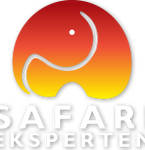
Botswana Fly-in
Experience the very best that Botswana has to offer in 1st class. This luxury safari in Botwana is a so-called fly-in safari. You fly between all of the best safari districts in Botswana, so that you can experience the highlights of this fantastic country without using too much time on transport.

TOUR HIGHLIGHTS
Short, comfortable flights, over incredible scenery, between your luxury camps
The endless view over the beautiful, dry savannah of the Nxai Pans and its classic big game
The Okavango Delta’s incredible mosaic of breathtaking scenery and rich animal life
The Linyanti reserve, home to one of the continent’s highest concentrations of animals
On this very comfortable safari you will experience how fantastic it is to fly low over the magnificent landscapes and wild animals of Africa. You will stay exclusively in luxurious camps, where every detail has been taken care of. This safari is for travellers who will not compromise when it comes to luxury, quality and comfort.
An undisturbed, private safari experience
Highly qualified guides and great wildlife experiences are at the heart of this safari in Botswana. The huge, very different concessions visited on this safari, Nxai Pan, Kwara and Lebala, are all privately owned which means that you won’t meet any other tourists on this safari than those staying in the same camp - a luxury that is to be found on very few safari tours. You can also swop staying in Nxai Pan Camp with a visit to its sister camp, Tau Pan Camp, which lies in the Kalahari Desert.
Beautiful landscape with baobab trees
Naxi Pan Camp lies on the edge of the salt flats of the same name, Naxi Pan. There are nine rooms, all of which have a view over a nearby water hole, where the game that live in the area come down to drink. The stars of the night sky are phenomenal out here, and the landscape, with the three huge thousand year old baobabs at the heart of these arid flats is spectacular.
Tau Pans herbivores and arid environment
Tau Pan lies in the Kalahari desert, and is famous for its many herbivores, which are especially prominent when a little rain has fallen and the grass begins to grow. The large number of herbivores also attracts a varied range of predators. Both here or in Tau Pan the local bushmen will take you on an exciting cultural adventure in the incredible surroundings.
Africa’s Crown Jewel: The Okavango Delta
In Kwara you will come to understand why the Okavango is regarded as one of Africa’s - or even the world’s - real gems. This concession of 1,700 km2 lies in the northern part of the delta and borders the Moremi game reserve, which is famous for its large numbers of big game animals. The camp has been built right next to an enormous flood plain, which is flooded for part of the year.
Lebala’s rich and varied animal life
Lebala is dominated by areas of open savannah with small areas of palm groves and woodland. Lebala lies next to the Linyanti-wetlands, which mark the border between Botswana and Namibia, and is home to a very rich and varied fauna.
Itinerary
DAY 1: DEPARTURE FROM EUROPE
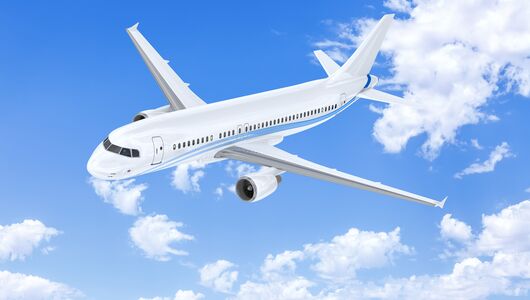
You will depart on your flight to Johannesburg via a European hub.
Meals and drinks will of course be included on your flight.
DAY 2: JOHANNESBURG, VIA MAUN, TO NXAI PAN

You will arrive in Johannesburg in the early morning, where you will catch a connecting flight to Maun in Botswana.
On arrival you will be met by a representative from Askari Tours, who will assist with your transfer to Nxai Pan in a light aircraft. These short flights are a major feature of this safari, and an incredible experience in themselves. The flights are not long, but you can quickly reach destinations which would be impossible to get to without spending a whole day driving through an otherwise nearly impassable landscape.
From the air you will enjoy an incredible view over the nearly endless landscape you find yourself in. Nxai Pan, together with Makgadikgadi Pan are some of the biggest salt flats in the world and are surrounded by arid savannah. During your flight you can see large herds of animals on their migration over the plains below you - a truly impressive sight.
Overnight at Nxai Pan Camp, all inclusive.
DAY 3: NXAI PAN

After your first night in the bush, where we can nearly guarantee you will enjoy a great night’s sleep (although there is a risk you will be awoken by the roar of a lion), you will get up early to make the most of your safari adventure. Splash a little water on your face, pack your camera and binoculars into a rucksack, perhaps have a quick cup of tea or coffee and a biscuit to help you wake up, and you are ready to set out into the gentle light at daybreak. For some animals it has been a long and dangerous night, and they can finally begin to relax after the dangers of the night have passed. Others have ended up as food for nocturnal predators. Many animals here are active at night, hunting down their prey under the cover of darkness, before finding cover as dawn begins to break.
Activities at Nxai Pan vary between game drives and walking safaris with bushmen. They are planned to suit your wishes and are carried out at a pace that suits you best. The waterhole in front of the camp always attracts many mammals and birds, which you can observe from your terrace with a drink in hand.
Overnight at Nxai Pan Camp, all inclusive.
DAY 4: NXAI PAN TO THE OKAVANGO DELTA
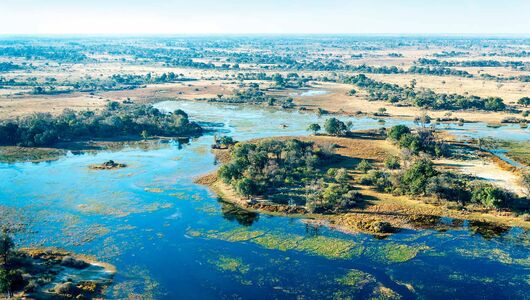
After an early morning safari followed by a lovely breakfast, it will be time to say farewell to your guide and the personnel of Nxai Pan Camp. You will be driven to the landing strip where a light aircraft will take you to your next stop, Kwara Camp. From the arid Nxai Pan your flight now takes you to the wetlands around Kwara, you will again be able to see many animals from the air. You will be met at the runway by your guide and driven directly to Kwara Camp where you will receive a warm welcome from the camp’s staff. After moving into your room, you will have lunch and have a couple of hours to relax in your new surroundings before you again go for a safari drive. Kwara Camp lies in a 175,000 hectare private concession on the borders of the Okavango Delta and is a part of this world famous wetland ecosystem.
Overnight at Kwara Camp, all inclusive - or alternatively at Little Kwara Camp, which is more expensive in the high season.
DAY 5: OKAVANGO DELTA
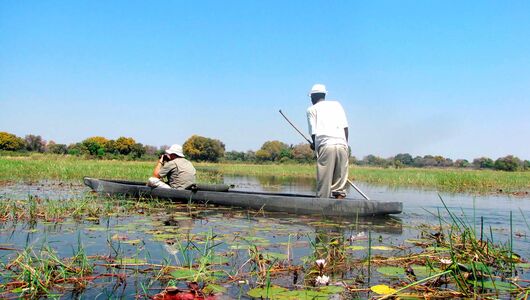
Kwara Camp also offers fantastic birdwatching, especially during our winter months when many migratory birds move south to escape the European winter. There are also an impressive number of resident bird species, who stay here all year round because of permanent availability of water in the delta. From the camp you can take part in photo safaris in open, 4 wheel drive safari vehicles, walking safaris, sailing tours in a two deck motor boat and canoe tours in a traditional mokoro (a dug out tree trunk) - all accompanied by the camp’s fantastic guides. A fishing trip for big catfish or tigerfish with their dangerous looking teeth, is also possible. All activities at Kawara can be arranged as you wish.
Overnight at Kwara Camp, all inclusive - or alternatively in Little Kwara Camp, which is more expensive in the high season.
DAY 6: OKAVANGO DELTA TO THE LINYANTI RESERVE

You rise early in the morning to go out into the bush and investigate what the animal noises during the night were all about. After a couple of hours you return to camp for a large brunch. Afterwards it is time to pack your bags so you are ready to take to the skies again and move on to your next camp. A short flight takes you to the Linyanti Reserve and Lebala Camp, where you will be met by another team of enthusiastic guides and friendly camp personnel. You will sleep in one of the camp’s 8 spacious tents. These large, luxurious tents are a wonderful place to stay and here you will quickly feel at home in Botswana’s wilderness.
This camp has no fences, so you can often see animals walking around the tents. After darkness falls, the paths between the tents and the camps main public areas are lit with petroleum lamps and a guard will always be on hand to escort you back to your tent after dinner. A wealth of activities and different types of safari are available in this camp.
Overnight at Lebala Camp, all inclusive.
DAY 7: THE LINYANTI RESERVE
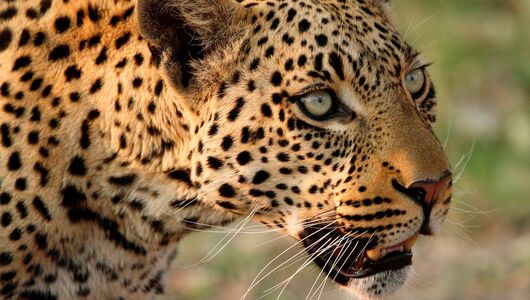
You will spend the whole day exploring this game rich reserve. It is possible to go on walking safaris and game drives in the morning, afternoon and after dark in the evening, when you can watch the rarely seen nocturnal animals with the help of powerful floodlights. During your stay at Lebala you are sure to see a wide range of different game animals that will be hard to beat anywhere else.
Overnight at Lebala Camp, all inclusive.
DAY 8: THE LINYANTI RESERVE AND DEPARTURE FOR HOME

Depending on when you have to fly out, there might be time for a final game drive before breakfast and your flight to Maun. From here you will first fly to Johannesburg, then further on to Europe - with many wonderful memories and great experiences packed in your baggage!
DAY 9: ARRIVAL HOME
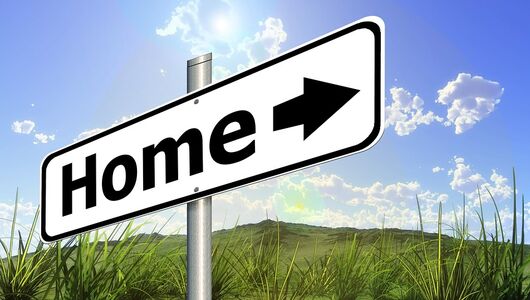
After catching a connecting flight in Europe you will arrive back in the early morning.
Accommodation on the tour

Nxai Pan Camp
Nxai Pan Camp opened in 2009 and today it is the only camp in Nxai Pan National Park that is open all year round. It lies facing to the east, with a view over the open grass covered plains that today cover the fossil lake floor or salt pan, from which it gets its name. This area was once covered by a huge prehistoric lake that once spread over central Botswana.
Read more
Lebala Camp
Lebala Camp lies hidden away in the southern part of the enormous 232,000 ha Kwando game area, next to the large wetlands of the River Linyanti marshes, on the border between Botswana and Namibia. The scenery is dominated by open plains and scattered palms and trees. The camp offers 8 luxurious guest tents, for max. 16 people. From the private terrace you have an outstanding view over the surrounding plains. Each tent has a large combined sitting-/sleeping area, a bathtub with feet and a charming outdoors shower cabin.
Read more
Kwara Camp
Kwara main camp features 8 luxurious guest tents, furnished in classic safari style, and offers accommodation for a maximum of 16 guests. All tents have been built on raised teak terraces. They all are equipped with a private bathroom, with a toilet and private outdoors shower. Your stay here includes 3 meals a day and all drinks. Meals are served in the intimate thatched lounge, from where you have a good view of the lagoon. The camp also has a swimming pool and a small shop.
Read moreAttractions on the tour
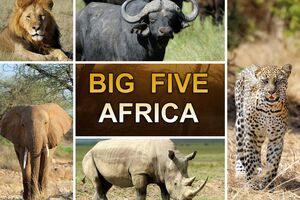
THE BIG FIVE
The Big Five is a historic term that comes from big game hunting. It groups together the five animals that were considered to require the most courage and skill to hunt: Elephant, rhino, buffalo, lion and leopard. The term has been readily adopted by today’s wildlife safaris, on which rifles have been swapped for a camera and animals are only “shot” through a telephoto lens. It is also widely used in the marketing of reserves, camps and lodges, where the “Big Five” can be found, and visitors have a reasonable chance of encountering them.
Read more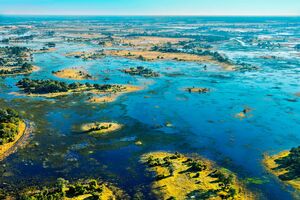
The Okavango Delta
Which animal characterises, or is the highlight of, a safari in the Okavango rather depends on where you stay. Here you can find both so-called “wet camps” and “dry camps”, if it is possible for you to do so staying in a combination of the two would be ideal. In the wetter areas the focus in on safaris in motor boats and in the so-called Mokoros - dug out canoes traditionally made from tree trunks, that can be polled silently through the swallow water.
Read more
Linyanti & Khwai
There is naturally also a wide range of prey animals for these carnivores. These include, for example, zebra, which appear in large herds during the dry season, and a number of different antelope species. The area is also home to many of the larger game animals such as giraffe, buffalo, elephant and hippos as well as an impressive number of birds.
Read morePrices
The Price Includes
- Return flights from N. Europe - Botswana
- All domestic flights from Maun and the campsites visited
- Safari in the Kalahari Desert
- Africa’s crown jewel, the Okavango Delta with its rich and varied wildlife
- The Linyanti wetlands on the border between Botswana and Namibia
- Game drives in the safari districts, incl. guides and entrance fees to the national parks.
- A total of 6 nights in 3 different luxury safari lodges with max 8 rooms
- Full board - fantastic meals you will never forget
- All drinks (including wines and spirits)
The Price does NOT Include
- Gratuities
- Visas
- Travel and cancellation insurance
- Everything else not listed under “the Price Includes”



